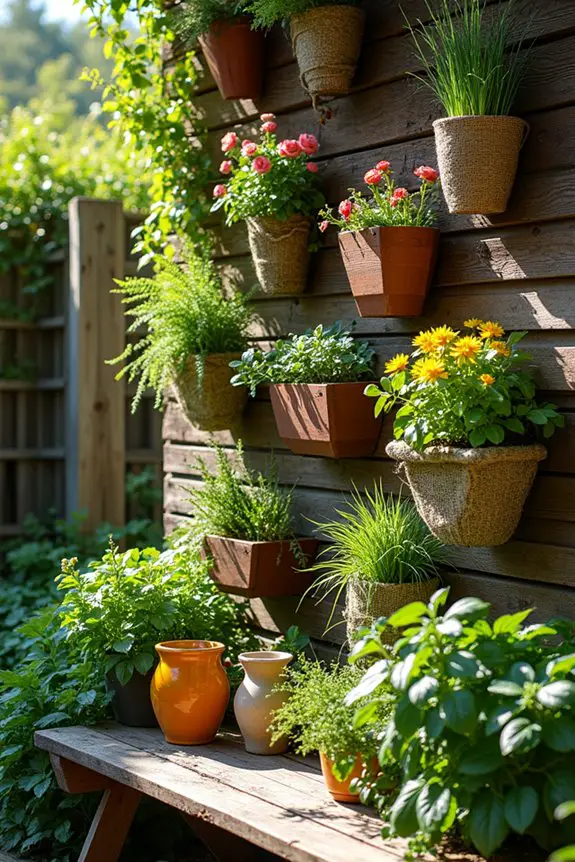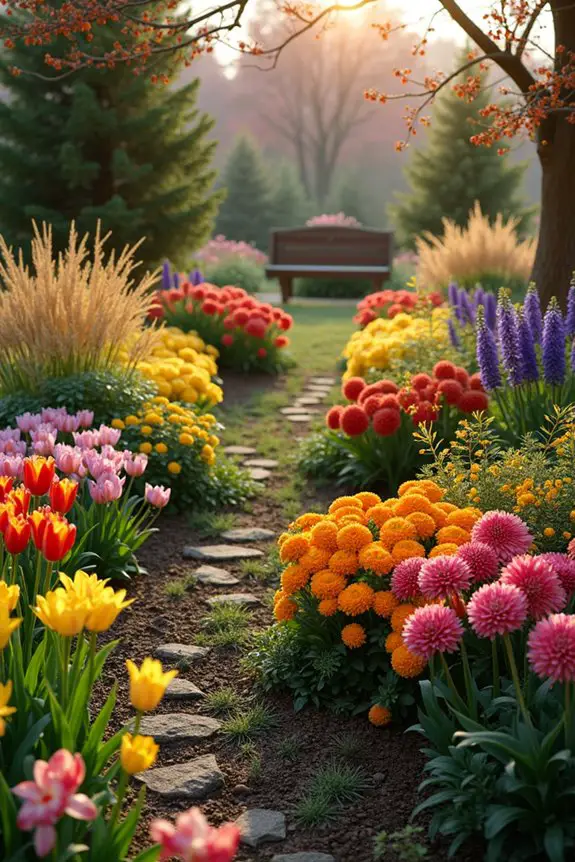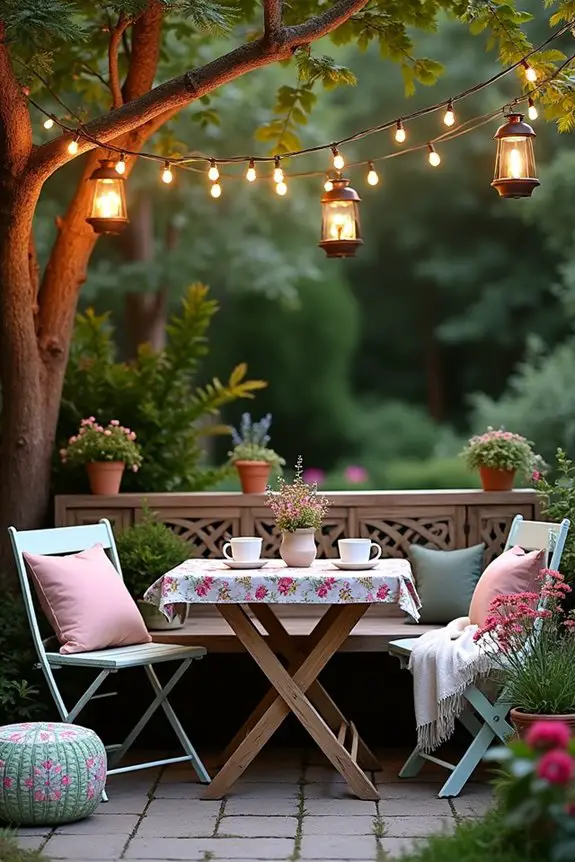Did you know that about 75% of people who garden say it makes them happier? It’s true! Imagine stepping into your own little paradise right outside your door. If you’re feeling stuck in a drab yard, you’re in the right place. There are so many ways to jazz things up, from vertical gardens to charming pathways. Let’s explore how you can transform your garden into an inviting retreat that makes your neighbors a tad jealous.
The Designs: Vertical Gardens
If you’ve ever thought about taking your garden to new heights—literally—you’re in the right place.
Vertical gardens can transform a plain wall into a lush retreat, and with the right hanging planter arrangements, you can create some serious eye candy.
1. Hanging Planter Arrangements
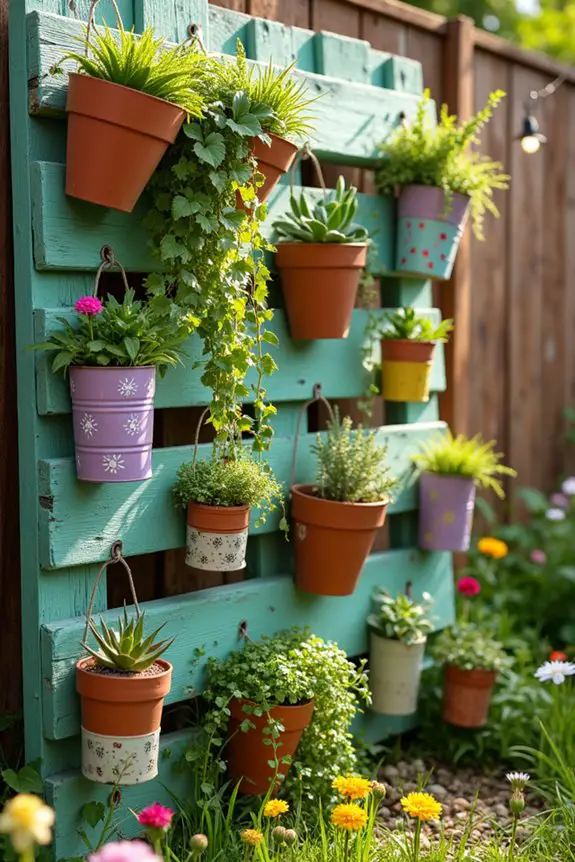
One of the most delightful ways to transform your outdoor space is by creating a vertical garden with hanging planters. This concept isn’t just a space-saver; it also brings life, color, and a touch of whimsy to your garden. Imagine stepping into your backyard or patio and feeling like you’ve entered a mini-jungle, filled with lush greens and playful blooms. Sounds dreamy, right?
To start your vertical garden journey, think about the wall or fence you want to adorn. Do you have a blank outdoor space that could use a splash of color? Search no more. A sturdy trellis or a wooden pallet can become your canvas. But hold on, don’t just get any old pallet—make sure it’s clean and free of splinters. I learned that the hard way while trying to create garden art. A splinter in the finger is no way to enjoy your gardening adventure. Additionally, while you kneel down to work, consider using a garden kneeler seat to make the experience more comfortable.
Next, you’ll want to gather your hanging planters. This could be anything from terracotta pots to quirky tin cans—really, the weirder, the better! You want your garden to reflect your personality. It’s also a great way to use up that collection of mismatched containers you’ve been hiding in your garage.
Potting soil and lightweight plants—think succulents, herbs, or even trailing vines—will complete your arrangement. Just be mindful of weight; too much heft up high could lead to a less-than-graceful tumble off the wall. Incorporating tools like UV grow light sterilizers can help keep your plants healthy and free from harmful bacteria.
Once you have your arrangements set up, hang them with care. Use sturdy hooks or brackets, and don’t be afraid to get creative. Layer different heights and styles, because the more eclectic, the better!
As you stand back and admire your work, you’ll likely discover that you’re stepping into your own little paradise. And hey, if your neighbors comment on how fantastic your vertical garden looks, just remember: it took a lot of trial and error, not to mention a few exasperated groans along the way.
2. Landscape Symmetry and Balance
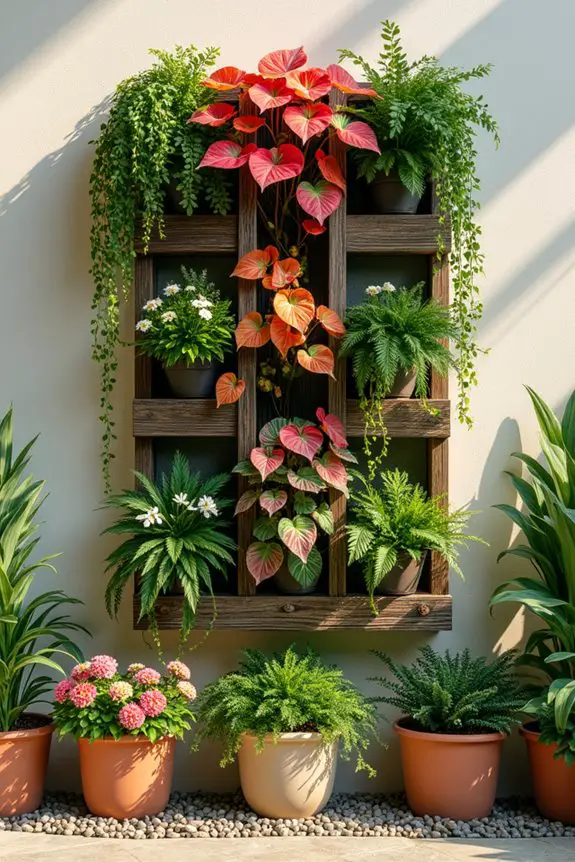
Creating a sense of landscape symmetry and balance in your vertical garden is like finding that perfect outfit—everything just clicks, and it feels right.
When your greenery is arranged thoughtfully, it invites peace and harmony into your outdoor space. Plus, well-balanced designs can make your garden look professionally curated, which is a fantastic bonus when you’re just a DIY-er trying to impress the neighbors.
So, how do you achieve this magical symmetry? First, consider your focal point. Every garden, even a vertical one, needs a “wow” element. It might be a stunning plant variety, a unique planter, or even an eye-catching piece of art. Position this focal point at eye level; it draws the attention and sets the stage for everything else.
Next, think about pairing plants with similar sizes or colors. Imagine concealing your collection of mismatched pots into a cleverly arranged installation. Additionally, a walk-behind fertilizer spreader can help ensure that your plants receive even nutrition, promoting healthy growth throughout your vertical garden.
Place taller plants behind shorter ones, allowing them to peek out without overshadowing. Like a good smoothie recipe, balance is key—too much of one thing might leave a bitter taste.
Don’t forget about breaking up the spaces. If you notice that one side feels heavier than the other, playfully add a pop of color or a different texture to create visual movement. Perhaps a bright red flower can rise up against leafy greens—suddenly, your garden is a conversation starter instead of just “that wall with stuff on it.”
Lastly, have fun with it. It’s okay if you find yourself moving plants around or switching things up every now and then. A vertical garden wall planter offers a perfect framework for achieving this balance.
I’ve rearranged my own vertical garden more times than I can count, each time thinking, “This is it!” only to change my mind after the first rain shower. And guess what? Every fresh arrangement feels like a new masterpiece waiting to bloom.
3. Garden Layout Strategies
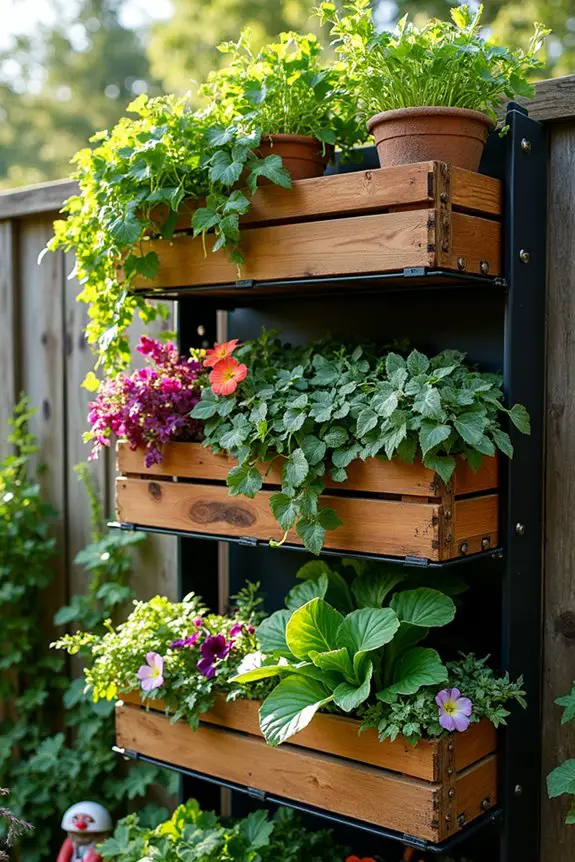
When it comes to vertical gardens, one of the smartest garden layout strategies you can embrace is the tiered design. Imagine a cascading waterfall of plants, each level showcasing different varieties, colors, and textures. Not only does this approach maximize space—perfect for those of us with small backyards or limited wall space—but it also adds a dynamic, vibrant visual flow that pulls you into the garden like a favorite song you can’t help but dance to.
To start, consider creating at least three tiers. The base can be sturdy and wide to support taller plants, while the middle and upper levels can hold lighter, trailing greenery. Think of this as crafting a culinary dish—each layer needs to complement the others, whether it’s a hearty base, a flavorful middle, or a delicate garnish on top. For example, larger, leafy plants like Swiss chard can anchor the bottom, while charming vines such as ivy can spill down from the middle tier, creating visual movement and texture.
Next, use materials that are both functional and stylish. You might opt for wooden crates or metal shelving, but whatever you choose, make certain they’re sturdy enough to hold the weight of your plant babies.
When I first tried this, I went for a DIY project with some reclaimed wood, and let’s just say, after one rainy night, I was sprinting outside to save my plants from an impromptu swimming lesson. Lesson learned: always check the durability first.
Don’t forget—light matters! Confirm that your tiered setup allows for adequate sunlight to reach each layer. If the top tier blocks light from the bottom, then your plants might as well be in a dark closet. It’s like trying to bake bread in a chilly kitchen; it just won’t rise.
Try to arrange your garden in a way where taller plants are positioned strategically to allow sunlight to filter down.
Lastly, make it personal. Use colorful pots or hand-painted labels to elevate the aesthetic while expressing your style—because who doesn’t want their garden to reflect their personality?
My own garden features an assortment of quirky pots that make me chuckle whenever I’m out there tending to my plants. It’s a delightful reminder that gardening isn’t just about growing plants; it’s about nurturing joy in your outdoor space.
4. Garden Pathway Design
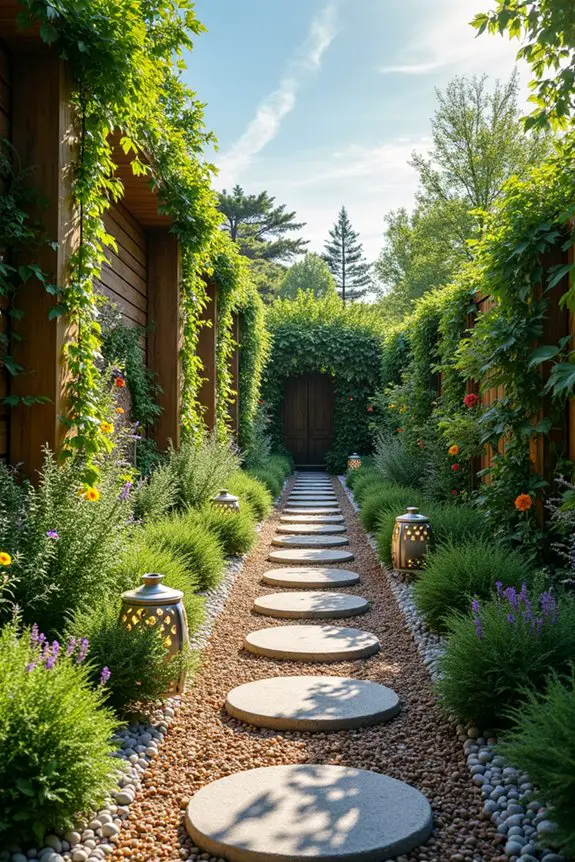
When it comes to vertical gardens, including charming pathways in your design can transform the whole experience. Not only do they provide a functional structure to help you navigate your garden, but they also add a whimsical touch that beckons you to explore. Think of pathways as the ribbons that tie your garden gift together, guiding visitors through lush greenery while creating an inviting atmosphere.
To get started, consider the materials for your pathway. Gravel is a favorite of mine because it’s budget-friendly and easy to maintain—but don’t underestimate the power of stepping stones to give your garden a more polished look. When I first laid down gravel, I thought I was just adding functionality. Little did I know, it turned my garden into a mini getaway, almost like a rustic retreat right in my yard.
You can even mix in small pebbles or colored stones to add a pop of personality. Just make sure to use landscape fabric underneath to prevent weeds, unless you enjoy the company of unwelcome green guests. Additionally, choosing the right seed starting soil mix can give your plants a healthy foundation as they grow alongside your pathway.
As you design your pathway, think about its shape. Curvy paths create a sense of discovery, making the journey through your vertical garden feel like an adventure. You could even play around with patterns, such as a zigzag or a winding serpentine route—there’s something playful about it.
However, let’s be honest; if your DIY project ends up resembling a spaghetti mess instead of a smooth path, don’t fret! Just name it “abstract art” and call it a day.
Another key consideration is lighting. Twinkling fairy lights strung along the pathway or solar lanterns can turn a simple garden stroll into a magical evening escape. I tried this once, and let me tell you, I felt like I was in a rom-com—until I tripped over the very rocks I thought looked so charming.
Use bright, inviting lights that not only illuminate the path but also highlight the beauty of your vertical garden.
Lastly, don’t forget to include some greenery around your pathway. Framing your path with low-growing plants or colorful flowers adds life and character. Consider planting herbs along the edge—rosemary or thyme can tantalize your senses while you stroll.
Honestly, if you’re brave enough to brush your hand through the leaves, you’ll feel like you’re walking through a culinary horn of plenty.
5. Colorful Plant Selection
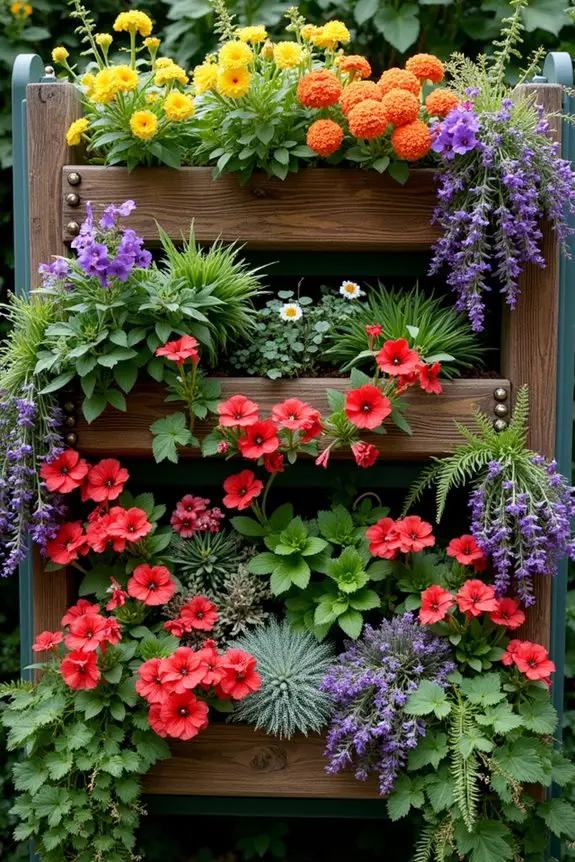
When creating a vibrant vertical garden, choosing the right plants can make all the difference, not just regarding looks but also in creating a specific mood or vibe. Imagine stepping into your garden and being greeted by an explosion of colors—bright reds, soft yellows, deep greens—that invites you in with open arms. Not to mention, a well-chosen mix of plants can maximize your space, offering a functional yet visually appealing layout.
So, how do you pick the perfect plants? First off, consider the colors you love. If you’re all about cool tones, think blues and purples—lush lavenders and striking indigos can create a calming oasis. Want something more vibrant? Go for fiery reds and sunny yellows. Just remember to mix it up; a single color palette can be lovely, but variety often adds the kind of excitement that feels, well, alive.
In my own vertical garden venture, I went wild with colors, plopping in everything from brilliant sunflowers to delicate violets. And while I felt like a Picasso of the plant world, there was a moment when I realized I might’ve gone a tad overboard. My poor neighbor, trying to be polite, referred to my garden as a “tropical jungle,” which, admittedly, was a polite way of calling it chaotic.
But you know what? I loved it. The mixed hues transported me every time I stepped outside, making the most mundane morning coffee feel like a mini-vacation.
Another tip is to think about the different textures of the plants. Mixing smooth leaves with spiky ones adds depth and interest to your vertical garden, making it not just a feast for the eyes but also a tactile wonder. Try combining delicate ferns with bold caladiums, or pairing fluffy grasses with sleek succulents. The contrast can draw the eye and invites a touch of curiosity, which is always a bonus.
Lastly, don’t forget about seasonal changes. Why settle for a garden that only looks good half the year? Opt for a mix of evergreens and seasonal bloomers to keep your vertical garden lively throughout the seasons. Every autumn, when your summer beauties start to fade, I love getting a jolt of joy from my winter pansies, reminding me that the garden is still very much alive.
In a nutshell, color isn’t just about aesthetics; it’s about creating a connection to your space. Whether you want something calming or something lively, the right plant selection could turn your garden not just into a vertical wonderland, but a true sanctuary. So, plunge in, get your hands dirty, and let your creativity root itself in the soil!
6. Plant Bed Elevation Techniques
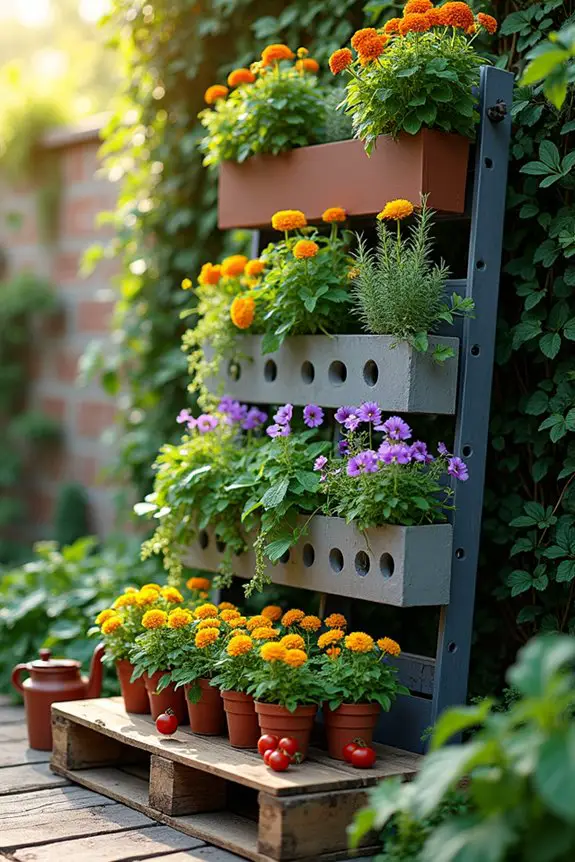
When it comes to vertical gardening, one of the coolest aspects is the chance to elevate your plant beds. Not only does this save space, but it also adds a striking visual element to your garden. Think of raised beds, hanging planters, or wall-mounted pockets—all of these elevate your plants literally and figuratively, creating a beautiful canvas where nature flourishes.
So, how do you start? First, consider the height that works best for your space. If you’re on a patio or balcony, a couple of feet off the ground can create a lovely display that doesn’t require you to bend down too much. Let’s face it—nobody wants to be that person groaning and grunting every time they tend to their garden. Keep it manageable and easy on your knees.
Next, think about what materials will work best for your design. Wooden pallets can be a creative and budget-friendly option, giving your vertical garden that rustic charm. If you’re feeling a bit fancy, consider using tiered metal frames or even concrete blocks with holes for planting.
Just imagine them filled with colorful flowers and lush greens—it’s like bringing a piece of art to life.
Now comes the fun part. Layout your plants! Think about how they’ll grow and which will get along well. Fill the bottom rows with heavier plants, like tomatoes or cucumbers, and let the lighter, trailing plants drape down from the top. It’s like layering an outfit—while your favorite pair of jeans (the veggies, in this case) might be the star of the show, those cute ankle boots (the trailing plants) add that special flair.
I remember the first time I tried elevating my plants. Let’s just say the results were a little… unconventional. My hanging planters turned into a kind of modern art installation, with a rogue tomato vine making a daring escape over the edge.
But it became a talking point, and honestly, who doesn’t love a little drama in their garden?
Lastly, verify your vertical garden has proper irrigation. Just like us, plants need their drinks—to thrive, they need to stay hydrated. Consider a drip irrigation system or make sure you’re set up for easy watering. Nothing says “garden disaster” like a parched plant looking up at you with sad, droopy leaves, right?
7. Garden Furniture Arrangement
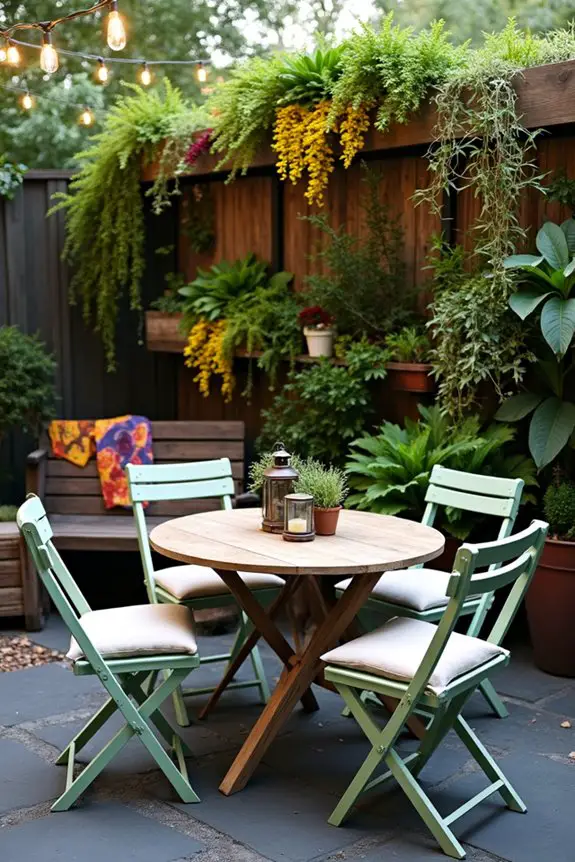
When it comes to creating a stunning garden, furniture arrangement can make all the difference. Think of it as setting the stage for your plant performers. The right vibe not only enhances the aesthetic appeal of your vertical garden but also makes it more functional and inviting. Imagine sipping your morning coffee surrounded by vibrant greenery, or having friends over for a cozy dinner amidst the leaves.
Start by considering your space. Is it a little nook or a spacious patio? The furniture should fit comfortably without overwhelming your plants. Lightweight seating, like folding chairs or even a bench, offers flexibility—you can move it around as needed. If you’re like me, always rearranging furniture like it’s a game of Tetris, you’ll appreciate this. Plus, it’s easy to step back and admire your garden from different angles.
Next, think about your seating arrangement. A small round table creates an intimate feel, perfect for sharing a cup of tea or a light lunch. Surround it with chairs, and you’ve got yourself a lovely spot for quiet readings or dinners under the stars. Oh, but don’t forget the layout! Position your furniture so that it doesn’t block sunlight from reaching your plants. You want your greens to thrive, not sulk in someone’s shadow.
And here’s a fun tip: Add in some natural elements. A wooden bench can blend beautifully with your vertical garden, providing that rustic touch. And why not repurpose some old crates as a side table? Duty-bound to function as both design pieces and plant stands, these accents can enhance the overall look, all while being light on your wallet.
Lastly, consider those details that bring warmth and personality to the space. This could be comfy cushions, string lights for a magical glow when evening falls, or even potted herbs that can double as decor and seasoning for your meals. You want your garden to be a personal oasis, right?
Trust me, when you take the time to thoughtfully arrange your furniture around your vertical garden, the outcome can be beautiful and functional. Just remember—you’re the director of this lovely show. Make it your own and enjoy the process.
8. Wildflower Meadow Inspirations
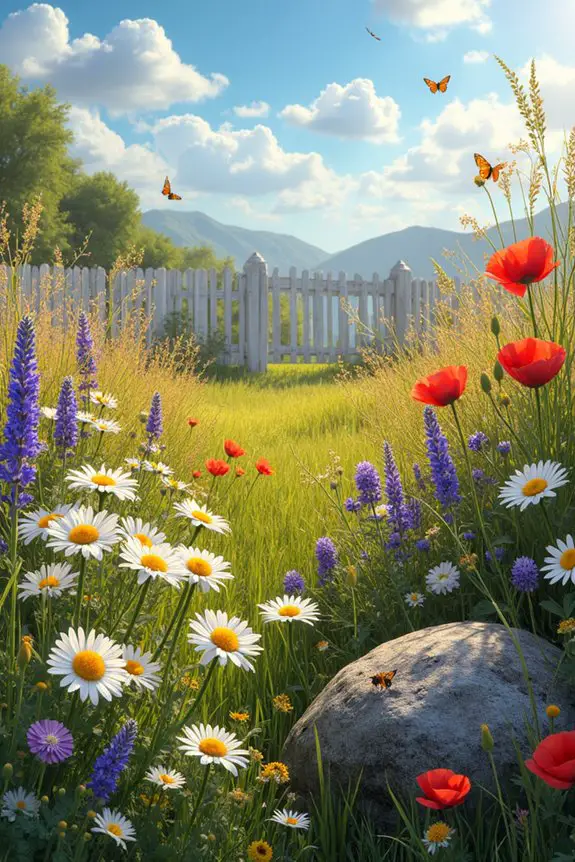
Creating a wildflower meadow in your garden not only adds a splash of color but also supports local wildlife. This natural design concept draws in butterflies and bees while giving you a gorgeous, ever-changing backdrop. It’s like letting nature throw a party in your backyard—who wouldn’t want that?
To get started, assess your space. Do you have a sunny section that could use a little love? Wildflowers thrive in bright sunlight, so pick a spot that soaks in those rays. If you’re like me, you might remember that one unfortunate summer when you forgot about the whole “sunlight” thing—trust me, take your time here.
Next, choose your wildflower mix. Look for local seed blends that match your climate and soil. You might feel like a mad scientist, mixing and matching different varieties, which is part of the fun. Think about how tall or short you want these flowers to be. Taller varieties can create beautiful backgrounds, while shorter ones are perfect for foregrounds—it’s like the garden version of arranging a good playlist.
When you’re ready to plant, prepare the soil. Clear any weeds and loosen it up a bit. Just think of it as giving your flowers a cozy bed for their roots. Scatter those seeds, and don’t be shy about it. I sometimes overdo it, feeling like a confetti cannon, but more flowers mean more chances for colorful surprises.
Now, the watering game. In the beginning, you’ll want to keep the soil moist but not soggy. Okay, let’s be honest—I’ve drowned a few plants before, so avoid that mistake by using a gentle spray or a watering can. Once your flowers sprout, they’ll need a little less love; they prefer to fend for themselves a bit more.
Finally, sit back and enjoy the transformation. What’s better than watching your wildflower meadow come to life? It’s a living canvas that changes with the seasons. You might even find yourself daydreaming as you sip your coffee, lost in the vibrancy of it all.
Just remember, patience is key. Like waiting for that cake to rise—sometimes the best things take a little time.
9. Eco-friendly Material Choices
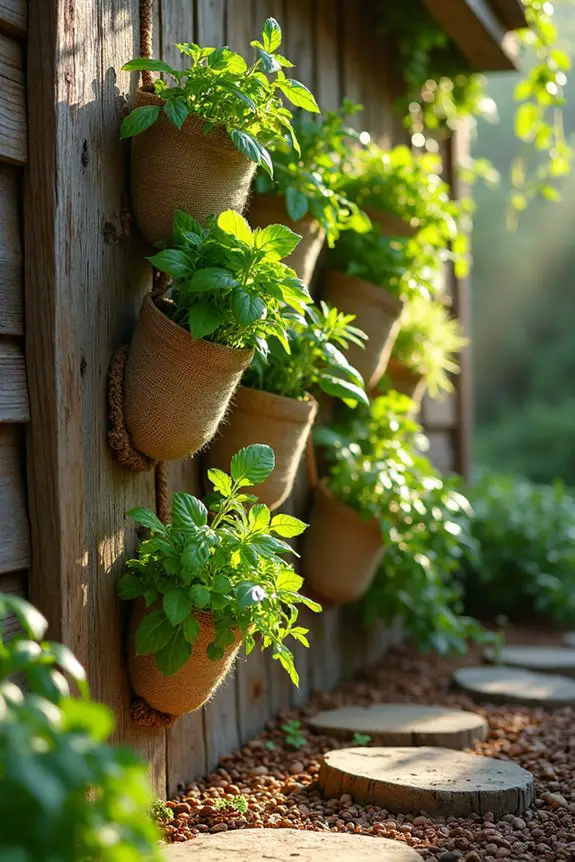
When it comes to garden design, vertical gardens are a game-changer. Not only do they save space, but they also bring a lush, vibrant vibe right into your home. You can transform an empty wall or a drab corner into a green sanctuary, making your outdoor space feel alive and inviting. Plus, they can help clean the air and keep your surroundings cooler, which is always a win. Who wouldn’t want to turn their small yard into an eye-catching oasis?
Let’s explore some eco-friendly material choices for your vertical garden. First up, think about using reclaimed wood. It’s like giving a former life a new adventure. You might stumble across some old pallets or pieces from a renovation project. Just sand them down to get rid of any splinters—unless you’re up for some DIY battle scars.
Next, consider natural fibers for plant pockets. Fabric pots made from jute or felt not only look stylish but are breathable, allowing roots to thrive. Who knew that cozy fabrics could also be great for plants? Just be sure to line them with a waterproof material to avoid any soggy situations—unless your plants want to experience a swampy vacation.
If you want to get a bit fancy, check out recycled plastic planters made from discarded bottles or containers. They’re lightweight, durable, and come in cool shapes. Plus, they’re a surefire conversation starter—imagine telling guests how those vibrant pots used to be bottles in the recycling bin.
Before you start assembling your vertical masterpiece, think about your plants. Herbs like basil and mint thrive in vertical gardens, which is perfect for adding some fresh flavor to your dishes. Imagine this: you’re out in your yard, plucking fresh herbs to top your homemade pizza. It doesn’t get much tastier than that.
Once you’ve got your materials ready, it’s time to create. Lay out your plan like a chef composing a delicious dish. Start with a frame—if you’re feeling adventurous, build one from reclaimed wood. You want something sturdy to support the green goodness that’s about to flourish.
Next, attach your plant pockets, making sure each one has enough room for roots to spread out. Then, fill them with quality potting soil, giving each plant its cozy home.
10. Functional Outdoor Living Spaces
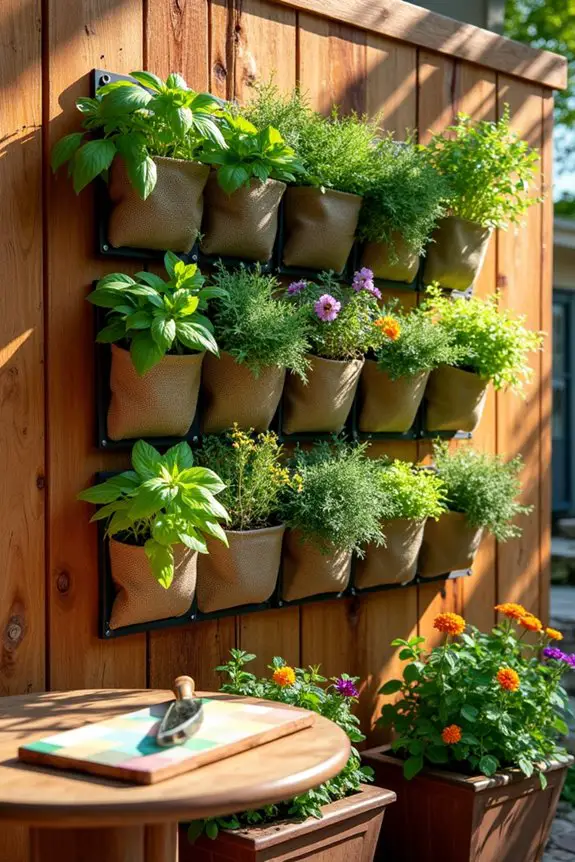
When it comes to outdoor living spaces, vertical gardens are like the secret ingredient to a delicious dish. They not only maximize space but also infuse your yard with greenery and beauty, creating a lively and inviting atmosphere that’s hard to resist.
Imagine stepping outside and being surrounded by vibrant plants without needing acres of land. How cool is that?
To create your own vertical garden, start by choosing a sunny wall or a corner that could use some pizzazz. This simple act of repurposing an underused area can transform it into a stunning focal point. Next, gather your materials. If you’re feeling resourceful, reclaimed wood is perfect for a rustic look that tells a story—or maybe calls out for a little adventure.
Sand it down to keep your hands splinter-free, unless you enjoy that kind of thrill.
Then, think about plant pockets. You could go for breathable options like jute or felt, which keep your plants cozy while allowing roots to spread. Just remember to use a waterproof liner unless you’re aiming for a makeshift swamp in your backyard.
Now comes the fun part: choosing your plants. Consider herbs like basil and mint for that fresh kick. Trust me, there’s nothing quite like having a fragrant herb garden right at your fingertips.
Imagine snipping off some leaves right before tossing them onto a pizza, feeling like a gourmet chef, even if you’re just reheating leftovers.
As you arrange your plants, think about the layout like you’re assembling a symphony. Bigger plants at the bottom, smaller ones at the top, creating a cascading effect that’s pleasing to the eye.
Keep in mind the watering schedule; these little green beauties need hydration, especially in their first weeks of growth.
Voilà! You’ve got a vertical garden that not only serves as a charming aesthetic but also elevates your outdoor living experience.
Watering Schedule Management
Having a solid watering schedule can be the difference between a thriving garden and a sad collection of wilted plants. So, what’s the trick? Start by checking the moisture level in your soil. It’s like finding the perfect cookie recipe—you want just the right amount of moisture.
Generally, watering deeply once or twice a week works wonders. Early morning’s best; this way, your plants get a drink while it’s cool, and the sun won’t evaporate it all.
Try to group plants with similar watering needs together because who needs extra drama?
And hey, if you forget sometimes, don’t beat yourself up. We’ve all had those “Oh no, I left the garden high and dry” moments; it’s all part of the gardening journey.

